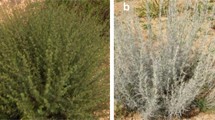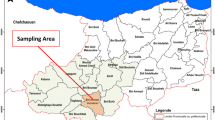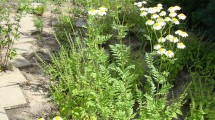Abstract
Roots of Astragalus membranaceus, Angelica sinensis, Glycyrrhiza uralensis and Codonopsis pilosula, which were often used as herbs in traditional Chinese medicine, were analyzed by Instrumental Neutron Activation Analysis (INAA). The samples were collected in Gansu, northwest of China and irradiated at the 15 MW heavy water reactor in China Institute of Atomic Energy (CIAE). The induced activities were counted by a well calibrated low background γ-spectrometer equipped with a high efficiency coaxial high-purity germanium (HPGe) detector. The concentrations of eighteen trace elements (Ca, Fe, Na, Zn, Ba, Rb, Ce, Cr, La, Co, Th, Cs, Sb, Sc, Sm, Hf, Eu and Tb) in the herbs were determined. Possible links between pharmacological action of the herbs and content of some elements were also discussed in this paper. The measured results were compared with the reported values in literature.
Similar content being viewed by others
Explore related subjects
Discover the latest articles, news and stories from top researchers in related subjects.Avoid common mistakes on your manuscript.
Introduction
Recently, as an alternative, traditional herbal medicine has been widely used not only in the developing countries but also in the industrialized world. In addition to the identity of organic compounds, knowledge of the elemental content in medicinal plants is also very important. Many trace elements play a significance role in the formation of active constituents which are responsible for their curative properties [1–3]. Some of these elements are vitally important for various metabolic processes of human body. They are closely related to human growth and general health. Deficiency or imbalances of these elements could cause physiological disorders [3, 4].
Moreover, with increasing industrialization and environmental pollution, it is necessary to check the content of some toxic elements in medicinal herbs. Therefore, the information about concentration of some trace elements in the medicinal herbs is significant. Some techniques which are usually used for trace elements analysis, are atomic absorption spectrometry (AAS), energy dispersive X-ray fluorescence (EDXRF), electro thermal atomic absorption spectrometry (ETAAS), inductively coupled plasma-atomic emission spectrometry (ICP-AES), inductively coupled plasma mass spectrometry (ICP-MS), particle induced X-ray emission (PIXE), photon activation analysis (PAA), and charged particle induced activation analysis (CPAA) [1, 5, 6]. Instrumental neutron activation analysis (INAA) is a reliable and effective method for multi-element determination at trace level with higher sensitivities than common methods [6, 7]. Several authors from different countries have reported the analysis of medicinal herbs of their respective countries by using INAA [8–15]. However, there is not sufficient data about Chinese herbs.
In this work, we determined 18 elements in four kinds of medicinally important Chinese herbs for the first time using INAA method, we hope our finding will be useful in setting the baseline of elemental content in medicinal plants. Local and English names of analyzed herbs and their uses [16] are given in Table 1.
Experimental
Sampling and sample preparation
Astragalus membranaceus, Angelica sinensis, Glycyrrhiza uralensis and Codonopsis pilosula are four of the most widely used herbs in traditional herbal medicine. Gansu province located in northwest of China is famous for Chinese herb production. The root samples used in the experiment were collected from the local market. Surface contaminants of the roots were removed by washing with deionized water twice and then with warm double distilled water. The useful parts of the samples were air dried in a clean drying chamber and then dried at 80 °C for 12 h in an oven. The dried samples were then crushed into a homogeneous fine powder of uniform particle size using an agate mortar.
Irradiation and counting
About 150 mg powder of each sample was packed in aluminum foil. Then, together with Standard Reference Materials (SRMs), the samples were irradiated at a neutron flux of approximately 3 × 1013 n cm−2 s−1 for 2 h in the 15 MW heavy water research reactor in China Institute of Atomic Energy (CIAE), Beijing. High purity Fe wire and Zr foil were used for comparator and neutron flux ratio monitors, respectively, in K0-NAA. After appropriate cooling, the gamma activities of the irradiated samples were measured with a well calibrated automated high-purity germanium (HPGe) gamma-ray spectrometry system (Canberra, ε = 35%, FWHM = 2.1 keV at 1.332 MeV for 60Co). The program, SPAN, was used for peak analysis and a hybrid K0-relative program, ADVNAA [17], for elemental concentration calculations. Quality control of the measurement was assured by the re-determination of standard reference materials NIST-1632a (Coal) and NIST-1570a (Spinach), as shown in Table 2. The measured values are in good agreement with the certified values. Some Chinese CRMs such as GBW 08503 (wheat) were also analyzed for quality control and method validation, using the above mentioned experimental conditions.
Results and discussion
The concentrations of eighteen minor and trace elements were determined on dry weight basis and the results are given in Table 3. Most of the herbs are rich in one or more elements, providing a possible link to the pharmacological action of the medicine.
Ca, Fe and Na were the most abundant elements present in samples and were found in mg/g levels. The concentration of Ca in these four herbs is high and ranges from 1.96 to 19 mg/g, with maximum value in Glycyrrhiza uralensis (19 mg/g). The concentration of Fe ranges between 0.48 and 0.93 mg/g, the highest is in the Angelica sinensis (0.93 mg/g). Na is an important element for the maintenance of acid–base equilibrium and of osmotic pressure of body fluids [1]. The concentration of Na ranges between 0.27 to 2.12 mg/g in these medicinal herbs. The highest concentration of this element was found in root of Glycyrrhiza uralensis (2.12 mg/g). Astragalus membranaceus has relatively lower value (0.27 mg/g). The elements Zn, Ba, Rb, Ce, Cr, La, Co, Th, Cs, Sb, Sc and Sm were found at μg/g levels and Hf, Eu and Tb presented the lowest concentrations and were found at ng/g levels. The concentration of Zn as well as Cr, La, Co, Sc and Sm are of the same magnitude for the four species. Ba is notably rich in Codonopsis pilosula (189.0 μg/g). From Table 3, we can see the concentrations of Th, Sb, Hf and Tb are fairly low. Their concentrations decrease in order: Th > Sb > Hf > Tb. The Eu is only found in Astragalus membranaceus with a very low concentration (41.6 ng/g). No toxic elements such as Pb, Cd were detected in the samples. This may be attributed to the fact that most of these medicinal plants are wild and that natural herbs located far away from urban area where there are little industrial and automobile activities.
The same situation has been reported for some medicinal plants in other regions [12, 14, 15]. The mean element concentrations in this work are compared with the mean concentration of literature reported values which are also determined by INAA method shown in Table 4. It is noted that the major elements obtained in this work were also obtained as major elements in published studies on some other medicinal plants.
Elemental content of twenty medicinal plants in Malaysia were studied [14]. In general, the concentration range of the elements Ba, Ca, Cs, Cr, Fe, La and Na determined in our samples is comparable with the mean concentration of others [14]. The results obtained by this work are also comparable with those published by Serfor-Armah et al. [15] for Zn, Sb and Sc, but not consistent with the values of Na and Ca. Most of the data given by Fakanhun et al. [12] are higher than this study except for Ba which is somewhat lower. This may partly be due to the differences of species. Their work analyzed tropical plant woods from southern part of Nigeria [12]. The result clearly showed that the elemental content in the medicinal plants varied depending on the species and places of origin.
Conclusions
A number of trace elements play an important role in the metabolism. The concentration of 18 minor and trace elements (Ca, Fe, Na, Zn, Ba, Rb, Ce, Cr, La, Co, Th, Cs, Sb, Sc, Sm, Hf, Eu and Tb) in four Chinese herbs have been measured using INAA technique. The elemental concentrations have been found to vary in a wide range from mg/g to ng/g in the analyzed herbs. However, no toxic heavy metal Pb, Cd was detected in the samples. From the established procedure in the experiment, we can see that instrumental neutron activation analysis (INAA) can not only be applied to herbs but also to trace some toxic elements in botanical samples.
With improvements to the INAA method, such as, variation of the irradiation and counting conditions, it is recommended that further analysis of medicinal plants collected from different regions of China be done for a cross-check of elemental contents. This could lead to a better understanding of the therapeutic action of natural herbs relative to their elemental levels.
We hope that the study of elemental composition for these four medicinal plants will throw more light on the pharmacological activities and their potential medicinal applications.
References
Yamashita CI, Saiki M, Vasconcellos MBA, Sertié JAA (2005) Appl Radiat Isot 63:841
Kanias GD, Tsitsa E, Loukis A, Kilikoglou V (1993) J Radioanal Nucl Chem 169:483
Balaji T, Acharya RN, Nair AGC, Reddy AVR, Rao KS, Naidu GRK, Manohar SB (2000) J Radioanal Nucl Chem 243:783
Naidu GRK, Denschlag HO, Mauerhofer E, Porte N, Balaji T (1999) Appl Radiat Isot 50:947
Kumar A, Nair AGC, Reddy AVR, Garg AN (2005) J Pharm Biomed Anal 37:631
Zaidi JH, Fatima I, Qureshi IH, Subhani MS (2004) Radiochim Acta 92:363
Wei YY, Chung C (1997) J Radioanal Nucl Chem 217:45
Rajurkar NS, Pardeshi BM (1997) Appl Radiat Isot 48:1059
Chien-Yi C (2004) Food Chem 84:545
Chien Yi C, Lung Kwang P (2001) Food Chem 72:255
Noorddin I (1995) Food Chem 54:133
Fakankun OA, Oluyemi EA, Akanle OA (1993) J Radioanal Nucl Chem 169:277
Ken-Shaw C, Chia-Liang T, Te-Hsien L (1993) J Radioanal Nucl Chem 170:265
Majid AAB, Sarmani S, Yusoff NI, Wei YK, Hamzah F (1995) J Radioanal Nucl Chem 195:173
Serfor-Armah Y, Nyarko BJB, Akaho EHK, Kyere AWK, Osae S, Oppong-Boachie K, Osae EK (2001) J Radioanal Nucl Chem 250:173
Runeng Z (2004) Resources of Chinese traditional and herbal drugs in Gansu. Science & Technology Press, Gansu
Bangfa N, Weizhi T, Pingsheng W (1997) J Radioanal Nucl Chem 215:77
Acknowledgements
The authors wish to thank reactor operations group at CIAE for arranging neutron irradiations for the samples.
Author information
Authors and Affiliations
Corresponding author
Rights and permissions
About this article
Cite this article
Fei, T., Dehong, L., Fengqun, Z. et al. Determination of trace elements in Chinese medicinal plants by instrumental neutron activation analysis. J Radioanal Nucl Chem 284, 507–511 (2010). https://doi.org/10.1007/s10967-010-0503-y
Received:
Published:
Issue Date:
DOI: https://doi.org/10.1007/s10967-010-0503-y




